
A chance discovery in 1901 by a local sponge diver just off the coast of the small Greek island of Antikythera has proven
to be a find which has been described as having a greater historical significance and value than the
Mona Lisa itself. To be more specific, the
discovery of an ancient shipwreck, believed to have been a cargo ship travelling from Rhodes to Rome, was found to contain a
device made of bronze and encased within a wooden case and which has been suspected for many years as being some sort of
computing device. Using the latest x-ray techniques, including tomography, this astronomical device and ancient computer
(known as the Antikytheran Mechanism) has now been studied in unprecedented detail and has been found to contain a
very complex series of 32 dials, gears and levers which very accurately define the motion of the sun, moon and the five
known planets at the time as well as the forecasting of lunar and solar eclipses. Furthermore, x-ray analysis revealed
the presence of text, approximately 2000 characters in length with the bulk of it having been recovered and deciphered
from the 80+ remnant pieces and which has yet to be released to the general public (as of December 1st, 2006). It is
believed that the Antikytheran Mechanism is most probably the work of
Poseidonius of Rhodes due to various written references
at the time of such an engineering device being constructed by him. This engineering marvel which has been dated to 80 BC
sheds new light on the engineering capabilities of the ancient Greeks and has been described as "more complex than any
instrument for the next 1,000 years" (see S&T article
here; to access The Antikythera Mechanism Research Project, click
here).
Note: The series of photographs below were taken at the
National Archaeological Museum in
Athens, Greece where the Antikythera Mechanism is on permanent display.
Please click on any of the images below to display in higher resolution

|
The Antikythera Shipwreck Background information surrounding this chance discovery in 1900 by sponge divers. Upper one-half of text is in Greek whereas the lower one-half is in English. Please click on the image to the left for a larger (and legible) version. |
||
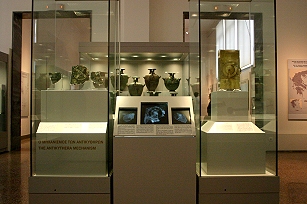
|
The Antikythera Mechanism Display The three largest and primary fragments are displayed on the left side of the exhibit; the results of the x-ray analysis are displayed in the middle of the exhibit; the replica built by Derek J. de Solla Price on the basis of x-ray analyses is displayed on the right of the exhibit. Please click on the image to the left for a larger version. |
||
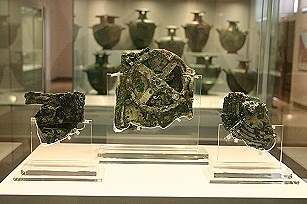
|
The Antikythera Mechanism Display (Antikythera 03b (20061227)) The three largest and primary fragments on display weighing 64, 369 and 99 grams respectively (left to right). Please click on the image to the left and/or those below for a larger version. |
||
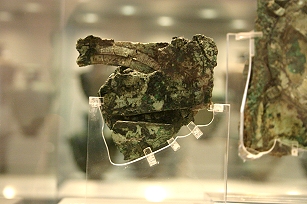
|
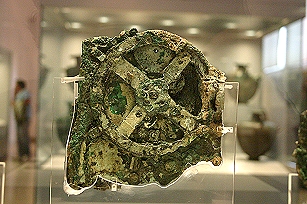
|

|
|
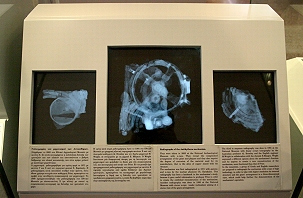
|
The Antikythera Mechanism Display Radiographs of the Antikythera Mechanism revealing intricate dials, gears and levers. Please click on the image to the left and/or those below for a larger version with descriptive text (Greek on the left, English on the right). |
||
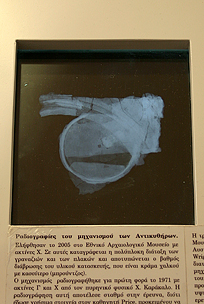
|
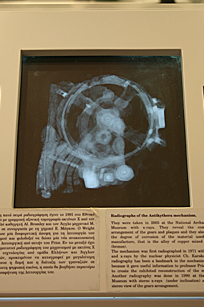
|
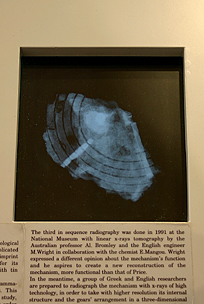
|
|
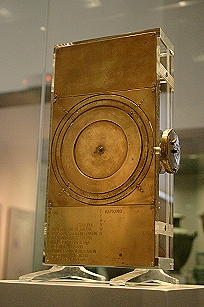
|
The Antikythera Mechanism Display The Derek J. de Solla Price replica of the Antikythera Mechanism based on the details revealed by multiple x- and gamma-ray studies including tomography. For further details including the physical measurements of the replica, click here. Please click on the image to the left and/or those below for a larger version. |
||

|
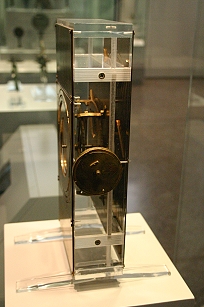
|
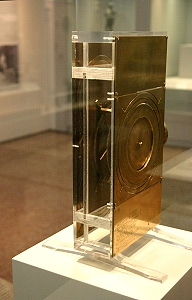
|
|